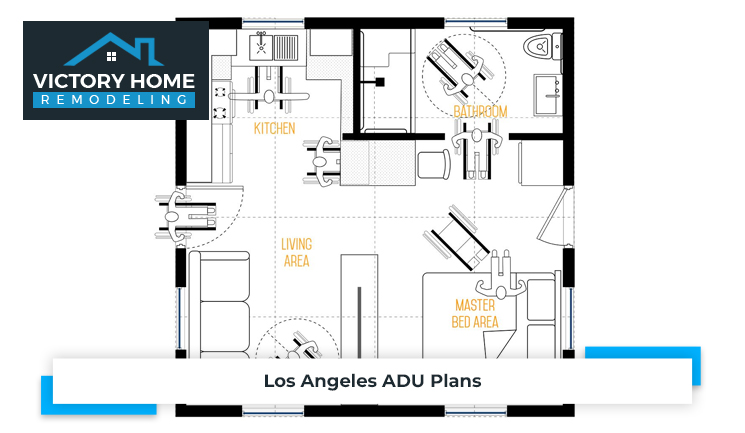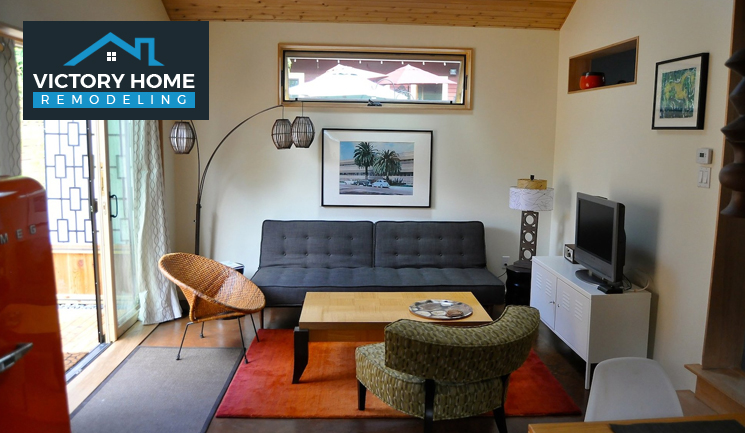As the city continues to experience a housing boom, ADUs have emerged as an innovative solution to maximize space and provide affordable living options.
To ensure a successful project, it’s crucial to carefully plan and adhere to all regulations set by the Los Angeles Department of Building and Safety (LADBS). Los Angeles ADU plans include determining if you need a permit, completing the necessary application and documentation, paying fees, having plans reviewed and inspected, and obtaining a Certificate of Occupancy.
Whether you’re a homeowner looking to leverage your property’s potential or a renter seeking alternatives to traditional apartment living, this guide will shed light on the diverse Los Angeles ADU plans available, the legal framework surrounding them, and the benefits they bring to the City of Angels. Buckle up as we navigate the exciting world of ADUs in Los Angeles.

There are countless advantages to adding an ADU to your property in Los Angeles, from financial benefits to environmental ones. Explore why building an ADU could be a game-changer for you and your community.
It can serve as a perfect home for aging parents, returning adult children, or other relatives, thereby keeping the family close while still maintaining a degree of privacy. Building an ADU is not just a smart financial move but also a practical solution to family housing needs.
ADUs are regulated by the City of Los Angeles Department of Building and Safety (LADBS), which has specific guidelines and regulations that must be followed for construction and occupancy. Here are some essential things to keep in mind when considering building a Los Angeles ADU plan:
It’s important to note that these regulations are subject to change, so it’s crucial to stay updated with the latest guidelines from LADBS before starting any construction.
When planning your ADU, a crucial aspect to consider is the design and layout. Tailoring the structure to your specific needs and preferences can help ensure your ADU serves its intended purpose effectively, whether to house relatives, provide rental income, or serve as a home office. The design should also consider the size restrictions imposed by the local laws and the available space on your property. Whether your ADU is detached, attached, or converted, it should seamlessly blend with the aesthetic of your main house, and most importantly, it must cater to the comfort and convenience of its occupants.
Another essential aspect to consider is budgeting. Constructing an ADU involves various costs, including design, construction, permitting, and potential upgrades to utilities. It’s vital to have a realistic budget that accounts for both expected and unexpected expenses.
Consult with Victory Home Remodeling to get a precise estimate of the costs and explore financing options if needed. It’s also important to factor in the potential return on investment, particularly if you plan to rent out the ADU. Remember that while an ADU can be a significant financial investment upfront, it can provide substantial long-term benefits.
Navigating the permit process for Accessory Dwelling Units (ADUs) in Los Angeles can be a complex task. Still, it is essential to follow all of the required steps to ensure that your project is completed legally and safely.
The first step is to determine whether or not you need a permit for your ADU project. In Los Angeles, all new construction and most remodeling projects require a receipt. However, some exceptions exist, such as minor repairs and maintenance projects.
To determine if you need a permit for your ADU, you can contact the Los Angeles Department of Building and Safety (LADBS). You can also check the LADBS website for a list of projects exempt from permits.
Once you have determined that you need a permit, you must complete a permit application. The permit application can be found on the LADBS website. In addition to the permit application, you will also need to submit the following documents:
Once you have submitted your permit application and all of the required documentation, you will need to pay the permit fees. The permit fees vary depending on the type of project and the size of the ADU. The permit fees for Los Angeles ADU plans differ depending on the kind of project and the size of the ADU. However, the typical cost of an ADU permit ranges from $1,800 to $8,000.
The following are some factors that can affect the cost of an ADU permit:
Once you have paid the permit fees, your plans will be reviewed by a LADBS engineer. The engineer will check your plans to make sure that they comply with all of the applicable building codes.
If the engineer approves your plans, you will be issued a building permit. However, if the engineer finds any problems with your goals, you must make the necessary corrections and resubmit your plans for review.
Once you have obtained a building permit from the relevant authorities, you can begin constructing your Accessory Dwelling Unit (ADU). It is crucial to keep in mind that to ensure compliance with safety standards and regulations, all construction work must be undertaken by a licensed contractor who possesses the necessary expertise and qualifications in the field.
Once your ADU has been constructed, you must have it inspected by a LADBS inspector. The inspector will verify that the ADU was built according to the approved plans and that it complies with all of the applicable building codes.

Once the ADU has been inspected and approved, you will be issued a Certificate of Occupancy. This certificate indicates that the ADU is safe and ready to be occupied.
To begin your ADU project journey with Victory Home Remodeling, call us today at 424-744-3754. Our team of professionals is ready to guide you through every step of the process, allowing you to create an ADU that fits your needs and exceeds your expectations. Don’t put off your dream project any longer—call us now!
Building an ADU in Los Angeles requires careful planning and adherence to local regulations. It’s essential to consult with professionals and stay updated on the latest guidelines from LADBS to ensure a smooth and successful construction process.
With proper planning, budgeting, and obtaining the necessary permits, you can create a valuable addition to your property that benefits you and your community. So, if you’re considering building an ADU in L.A., don’t hesitate to start the process and take advantage of the numerous benefits it can provide.